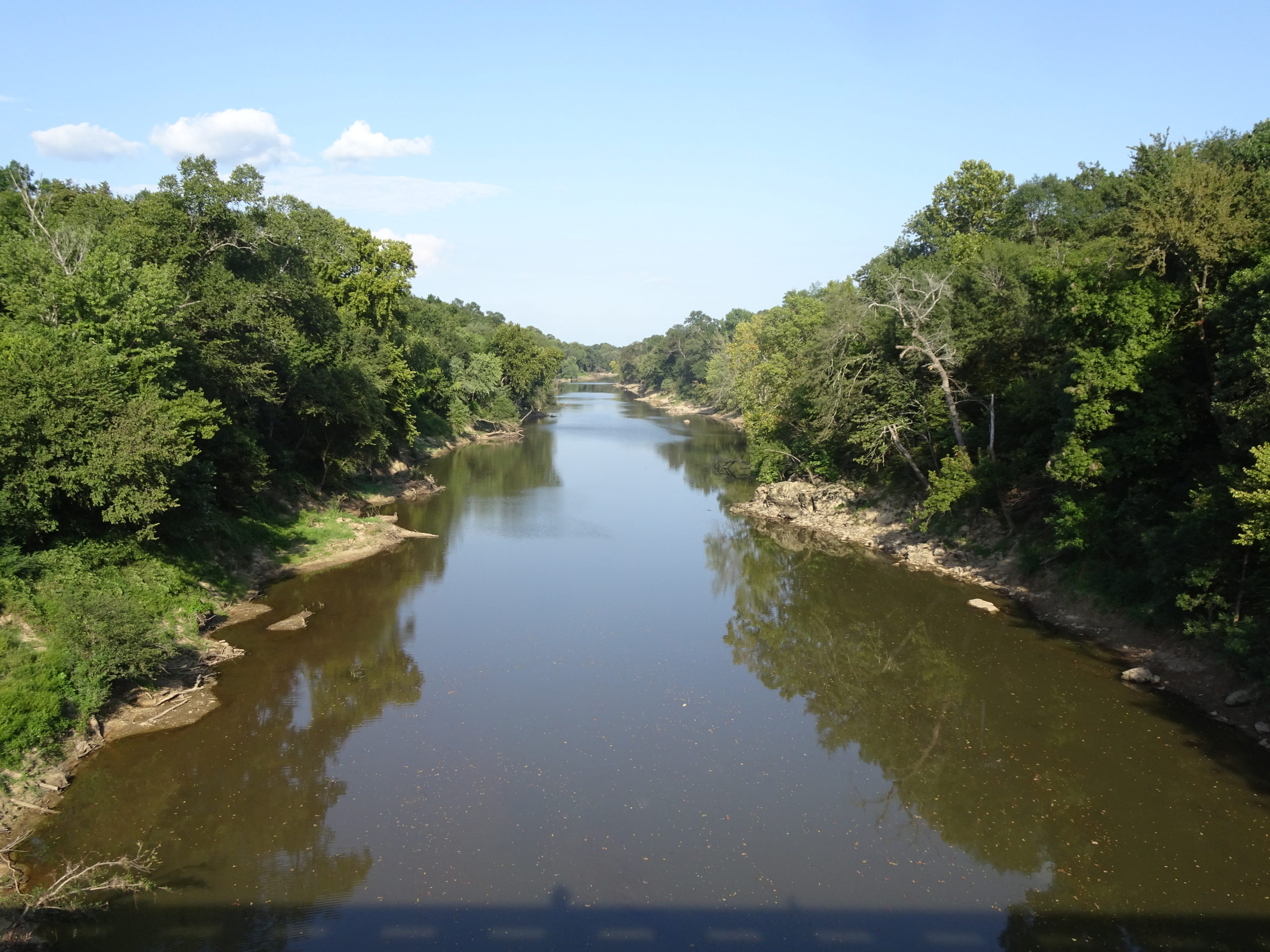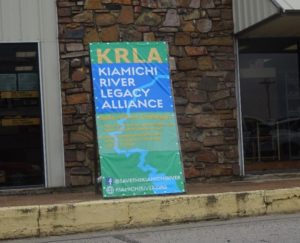Apply now to join our next cohort of Community Science Fellows and Community Leads!

View of Kiamichi River from Highway 271, the major north/south highway for Pushmataha County, Oklahoma. Credit: Bill Redman.
The Kiamichi River is a key shared water resource in southeastern Oklahoma, and it’s facing water diversion threats from hydroelectric projects, potentially creating issues for both basin residents and endangered mussel species on the river. The Kiamichi River Legacy Alliance is working to identify and fill critical knowledge gaps to better understand how diverting water from the river will impact the ecosystem. By creating systems for gathering and assessing hydrologic data, the KRLA will be able to accurately describe how proposed projects will impact the hydrology of the Kiamichi River, rather than relying on data from private economic interests. The community will also be able to contribute to the sustainable use and protection of the river into the future.
The Kiamichi River basin covers a crescent of land in southeast Oklahoma that extends from its headwaters near the Arkansas border to its confluence with the Red River near the Texas border. The 172–mile‐long Kiamichi River flows through three Oklahoma counties (LeFlore, Choctaw, and Pushmataha), and the basin itself spans six counties. Water is the primary natural resource in the region, and the Kiamichi River represents a key cultural, economic, and environmental resource for the local community.
The Kiamichi River has faced several water diversion threats. Most recently, Oklahoma City was granted a permit to divert water from the river, and Tomlin Energy was permitted to divert run-off stream water near the headwaters of the Kiamichi River for a hydroelectric project. These projects compound existing concerns related to likely future drought conditions in the basin. On top of water quantity concerns, stakeholders have significant water quality concerns. Decreased flows increase water temperature, increasing organic growth and hindering water treatment at downstream municipalities, many of which are already under economic pressure. Basin residents are also concerned about the downstream impacts of reduced flow and increased sedimentation on water quality in the river system. The EPA has deemed the two largest sources of drinking water – Sardis and Hugo Lakes – as impaired, and mercury has been detected in fish in both lakes at levels warranting state advisories against fish consumption.
Mussels native to the Kiamichi River have been especially negatively impacted by the ongoing drought conditions and water management. Twenty-nine species of mussels live in the Kiamichi River, including the federal and state endangered Ouachita rock‐pocketbook (Arkansia wheeleri), Scaleshell (Leptodea leptodon), and Winged Mapleleaf (Quadrula fragosa). These keystone species, regarded as the canaries of the river, have declined significantly in recent years.
 The Kiamichi River Legacy Alliance formed in 2016 to protect the river from water diversion threats and to ensure the conservation of the river well into the future. The Alliance reaches over 7,000 citizens through their engagement and outreach efforts, which include hosting town halls, meeting with legislators, and organizing a citizen science program on the river. They are seeking support to understand the ecological and hydrologic realities of the Kiamichi River system so that they can protect their shared ecosystem for future generations.
The Kiamichi River Legacy Alliance formed in 2016 to protect the river from water diversion threats and to ensure the conservation of the river well into the future. The Alliance reaches over 7,000 citizens through their engagement and outreach efforts, which include hosting town halls, meeting with legislators, and organizing a citizen science program on the river. They are seeking support to understand the ecological and hydrologic realities of the Kiamichi River system so that they can protect their shared ecosystem for future generations.
A long-term vision is to create a remediation program for the Kiamichi River, improve its water quality, recover mussel populations, and protect the river for future generations to enjoy. A critical starting point to achieving restoration of the Kiamichi River is to develop a solid understanding of the hydrologic regime of the system.
The first priority for this project will be to engage with a hydrologist to assess the existing hydrological data and identify any key gaps. A second priority is to develop a methodology for independently assessing the impacts of diverting water away from the Kiamichi River. The Alliance has existing relationships with other subject matter experts; ideally, an interdisciplinary team would work collaboratively to holistically assess potential water diversion threats.
Objectives:
Desired outputs include:
Protecting community interests and planning for future needs: AGU’s Thriving Earth Exchange helps concerned residents near Oklahoma’s Kiamichi River collect data for better water management decisions
Drought has always been part of the landscape west of the Mississippi River, and scientists have become better at measuring it and mapping it in the last century to more accurately chronicle precipitation, temperature, groundwater, and surface water. The National Drought Mitigation Center at the University of Nebraska-Lincoln updates the data for its drought monitor each Tuesday, mapping six levels of increasing concern across the nation. Western states and a swath from the Dakotas to Texas are routinely under threat with extreme- and exceptional-drought indicators of cherry red and maroon juxtaposed with lusher regions in yellow and white.
Read the full story here.
The Kiamichi River, in southeastern Oklahoma, is a pristine 177-mile river with headwaters in the Kiamichi Mountains, on the Oklahoma border with Arkansas. But it won’t stay clean if the state has its way: lawmakers want to divert the flow of the Kiamichi to meet the water needs of the Oklahoma City area, and possibly sell water to Texas. Another threat comes from a Texas developer who wants to build a 1200-megawatt hydropower facility on the Kiamichi River.
The Kiamichi River Legacy Alliance, however, is up for the fight. The Alliance, made up of community members who live on or near the river, was formed in 2016, when news of these plans came to light. Since then, they have been waging a long legal battle, on several fronts, to protect their river.
To create a baseline understanding of the good health of the Kiamichi, the Alliance partnered with Thriving Earth Exchange to understand the river’s hydrological regime in order to identify and address water quality and quantity concerns. They are also working with Community Science Fellow Laura Bartock, who is helping the Alliance find the resources they need to identify the potential impacts of these projects.
We sat down with Alliance members Bill Redman and Laura Bartock to learn more about how they plan to protect the river they love.
How would you describe the Kiamichi River area to someone who has never been there?
The Kiamichi River has a rock-and-gravel-based riverbed, and it flows pretty well in the spring and winter, but slows to a trickle in the summer, creating the large pools of water that are the perfect habitat for mussels, catfish and other aquatic life. Large trees lean out over the river, creating shade, and you can tell it’s been that way for generations. And in the summer time it has a distinctive smell—clean, fresh water.
What do you see as the unique strengths of this community?
We’re all very passionate and devoted to passing on to the future what we’ve been given. The land and the river is essentially unchanged from our great-grandparents’ day. We’re not necessarily against economic development or sharing water, but there’s ways to do it that won’t destroy what we’ve got. We think we’ve got the law on our side, too. We are standing up and fighting, not letting somebody come in and destroy what has been passed down to us.
The Alliance has a strong connection to its community, and its members are very dedicated, collecting samples and signing petitions. The people in the community are really passionate, and the Alliance does a great job keeping them informed and answering the questions they have. In addition, the Alliance’s knowledgeable members and AGU partnership will hopefully help us develop the tools and knowledge to enable us to win our battles.
What do you see as its unique or surprising challenges?
Oklahoma City has a strong need for water, and has already used up several other sources as it goes further and further east for more. The Kiamichi River is a big prize, and non-locals have dollar signs in their eyes fantasizing about obtaining all that water. But by diverting water, building pipelines, and flowing it down the river, they are going to mess up the whole aquatic system. Southeastern Oklahoma is very different from the rest of the state, both in its geology and in the fact that there has never been any hydrocarbon production in the watershed to speak of. The rivers in the region are still pristine.
The Alliance’s whole mission is to see that the river remains the way it is. Other Oklahoma rivers have been polluted from oil and gas production, and aren’t anything like they used to be. Ours, in a more secluded part of the state, are still in pretty good shape. There’s other ways the state can get water from the river, but they are more costly, and they just want it the cheapest way they can get it.
In addition to the river itself, there are at least three federally-listed endangered freshwater mussel species in the Kiamichi. These plans will disrupt the life cycles of those endangered species and ultimately cause their extinction. The river also has an under-investigated interaction with the Antlers Sands aquifer. That’s why working with a hydrologist is important. If they cut the water off before it gets to Antlers Sands, that aquifer could be diminished, with deleterious effects all across southern Oklahoma.
What changes do you think your project will bring now, and 20 years down the line?
We would hope the river would be just like it is now, 20 years down the road. We can get there, but we’re a tough phase, with legal briefs and lots of river research. Twenty years from now, it’d also be great to see a continued, robust citizen science effort monitoring water quality and quantity, with the community still engaged in its ecosystem helping manage and maintain its natural ecosystem.
Kenneth Roberts is an analytical chemist, the Chairperson of Chemistry and Biochemistry at the University of Tulsa, and the founder and president of the Kiamichi River Legacy Alliance. He leads the efforts of the group to gain a better understanding of their local ecosystem.
Lauren Haygood is a graduate student at the University of Tulsa, studying the biogeochemistry of the Kiamichi River. Lauren organizes community science efforts to collect water quality data throughout the basin. She is also part of the AGU’s Voices for Science Program and serves as a student representative to the Soil and Water Conservation Society.
Johnny Robbins is a landowner and a board member of the Alliance. Johnny lives 30 feet from Kiamichi River and has witnessed firsthand the degradation of the river over the past decades. He is concerned about the water quantity and quality.
Bill Redman is the Secretary and board member of the Alliance. Bill was born and raised on ranch on the Kiamichi River and has over 30 years of experience as a research chemist.
Laura Bartock is an experienced facilitator, science communicator, and social scientist. Laura works for the Association of Science and Technology Centers, where she helps member institutions – science centers, museums, zoos, and the like – build capacity for supporting community-centered science and public engagement on issues of concern in their communities.
Randy Stotler is a hydrogeologist and isotope geochemist, and Associate Professor at the University of Waterloo and Adjunct Professor at the University of Kansas. He has 20 years of experience studying water resource issues, including groundwater-surface water interactions, in the Great Plains and around the world.
The Kiamichi River Legacy Alliance (KRLA) is a grassroots group of concerned citizens whose mission is to peacefully promote awareness, conservation, and protection of the Kiamichi River and its tributaries. Through various forms of media and educational programs, we hope to keep people informed on actions that can cause damage to the Kiamichi River water quality and quantity. The Kiamichi River is considered the most unique and diverse river in the state of Oklahoma. By diverting water to cities or allowing private companies to create dams along the river, the richness of the river will be destroyed forever. When large cities in Oklahoma and other states attempt to drain the Kiamichi River for profit, or dam it to create electricity, the river will no longer be able to sustain the wildlife it supports or the citizens who rely on the river for their livelihood.
This project is supported by funding from the Gordon and Betty Moore Foundation.

(c) 2024 Thriving Earth Exchange